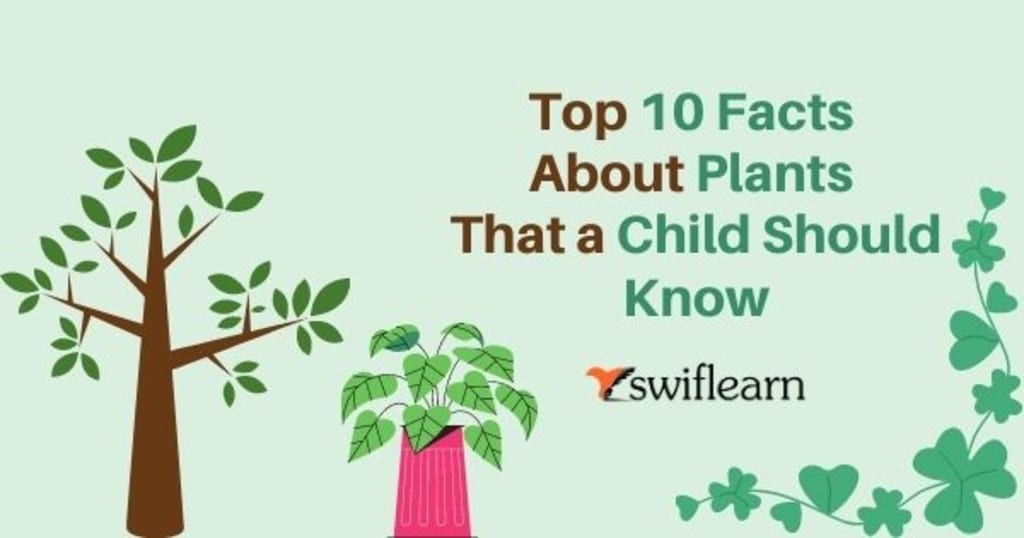Top 10 Facts About Plants that a Child Should Know - Swiflearn
The remarkable and wondrous plant world is full of mysteries and discoveries. These all astonish us at every step. Plants are the most sophisticated species, and also intelligent ones. They carry the innate ability to sing, dance, and avoid predators. They are power-packed with hidden surprises also!

The remarkable and wondrous plant world is full of mysteries and discoveries. These all astonish us at every step. Plants are the most sophisticated species, and also intelligent ones. They carry the innate ability to sing, dance, and avoid predators. They are power-packed with hidden surprises also!
Moreover, their various characteristics are quite similar to human traits. Leaving aside all these aspects, the most important are the parts of plants for kids. The world of the same is never-ending and very fascinating. Right from an early age, we all surrounded by plants. The primitive forms of living beings on Mother Earth are the plants we have around us. They support all the other living arrangements on the earth. Plants are present on water, land, and also inside the oceans. They can grow wherever possible and can withstand even natural calamities. You will thus always notice plants growing from the building walls! Also, many plants survive dangerous floods or storms.
Read the top ten facts about the plants, and the parts of plants for kids to gear your knowledge with some true wonder!
Top 10 facts about parts of plants for kids:
Autotrophs and carnivores:
Plants have the innate capability to prepare their food. They do the same with the help of photosynthesis. The entire process is on the place with the help of carbon-di-oxide, light, and water. The method as the whole characterizes the plants as Autotrophs. Apart from these varieties, there are also a handful of plants found that are both carnivores and even parasites! For instance, plants known as Nepenthes eats small insects to obtain nitrogen for their further growth.
Also Read: 5 Things to check before choosing tuition for your kid
Inter-cellular bridges:
All plant cells are of the prominent cell wall. It makes the outer layer of the cell thick and robust. It thus can withstand any physical damage. There are some cytoplasmic bridges amid the cells. These bridges are inter-cellular one’s known as Cytoplasmic bridges within the cells. These bridges are called well-known Plasmodesmata. This entire link aids in the plant’s healthful movement, along with other materials present in-between the plant cells. They also help in inter-cell communication.
Age of plants:
The big tree’s age calculated by counting the rings present in the trunk. The botanists rely upon the annual rings to scientifically calculating the period. These rings also assist in determining the environment’s conditions and various climatic transformations during the plant’s entire life. These rings initiate from the growth of new tissue, known as Vascular Cambium found near the bark. The eldest rings are located towards the center, while the new ones at the periphery of the trunk.
Grow toward the sky and light:
The plant generally grows facing the sky. It is owing to its ability of the plant tissues to recognize the available light. Irrespective of the seed’s position in the soil while germination, the plant always grow facing the sun and sky. This particular characteristic of the plants has by plant growth hormone, scientifically known as Auxin.
Release Oxygen:
All humans and animals breathe Oxygen to live. They breathe in Oxygen and breathe-out Carbon-di-oxide. The plants do a similar activity, but vice-versa. The plants breathe-in carbon-di-oxide and breathe-out Oxygen. And the carbon-di-oxide amount inhaled is comparatively more than they release via respiration.
Perspiration (sweating):
Through Stomata, the plants give out heat, in the form of water vapor. When the temperature soars high, the guard cells close to the stomata open and release the water. The plants’ perspiration to give away the heat in water form.
Sign up for a FREE trial class at SwifLearn now!
Dormant seeds:
The plants’ seeds propagate the offspring. These seeds are dormant. Individual seeds remain dormant for many years and keep on growing when they get exposed to suitable weather conditions, soil, light, and water.
Epiphytes:
These are one variety of plant growing on the other plants’ surface. The small shrubs, known as Epiphytes (epi =above; Phyto= plant), cannot avail of the adequate amount of sunlight in the dense forests. And they keep on growing on the plants’ surface very quickly.
Withering of leaves:
Periodically the plant leaves wither. In this way, the plants get rid of the old leaves, and new leaves take their place. The withered leaves help in expelling the toxic waste from their entire body. Mostly these fallen leaves consist of various poisonous metabolites.
Also Read: Top 5 Aids to Learn Math for Kids
Pollination and seed dispersal:
All plants undergo the process of sexual reproduction. It is commonly known as Pollination. But then the pollination usage is never restricted only amongst the plants. Animals too undergo this process. Most insects and birds depend upon flowers to get food. The food is in the form of nectar. In this process, they get their food in the nectar form. While doing so, they disperse the plant’s pollens, while transferring the male gametes to the flower’s female organs. It is similar to the fruits and has seeds. The animals eat these fruits and disperse the seeds in many places, in forms of their droppings. Later, these seeds germinate into new plants, at a reasonable distance from the ‘mother plant.’
By reading the top ten facts, relating to the parts of plants for kids, you ought to have a fruitful experience. The world of botany is massive and endless. And interesting also. Share the same facts related to the parts of plants for kids, and open the world of a surprise to your little ones!
Article Source: https://swiflearn.com/blog/facts-about-plants-a-child-should-know/





Comments
There are no comments for this story
Be the first to respond and start the conversation.